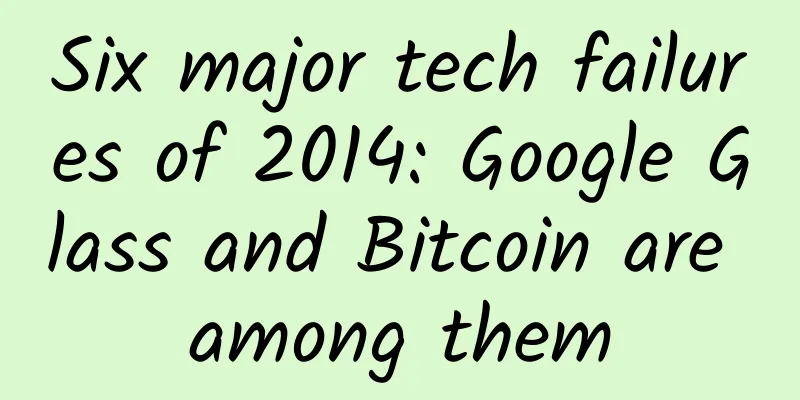Six major tech failures of 2014: Google Glass and Bitcoin are among them

|
Google Glass Although we read about scientists making breakthroughs every day in the newspapers, in fact, the vast majority of technologies fail, mainly because they cannot reach the scale of application, which makes them lack relevance to human life and leads to failure. The reasons for technological failure are of course unpredictable, otherwise, the technology may have been strangled in the cradle. In 2014, we witnessed many technological failures, whether it was the much-hyped "Google Glass" or the stem cell research that caused researchers to commit suicide due to fraud. In its report on December 31, 2014, the Massachusetts Institute of Technology (MIT)'s Technology Review Magazine sorted out the six most interesting technological failures of 2014. Listing failures is not to shame us, but to alert us. 1. Google Glass In April 2012, Google introduced "Google Glass" to the world. This augmented reality wearable smart glasses integrates a smartphone, GPS, and camera. It can display real-time information in front of the user's eyes. The user can upload photos, send and receive text messages, check weather and road conditions, etc. with just a blink of an eye. Moreover, users can surf the Internet without using their hands; process text messages and emails; in addition, wearing this glasses, users can also use their voice to control taking photos, video calls, and identifying directions. In July 2014, Google Glass also officially opened the live broadcast function. Although these glasses caused a sensation when they were first launched, as of the end of 2014, the expectation that these $1,500 wearable glasses would become a market darling like the iPhone, causing people to line up all night wherever they go, may be dashed. For various reasons, these glasses have not yet been widely promoted and used. According to the survey, nearly half of the application developers have stopped developing applications for Google Glass, and the version for ordinary consumers has been postponed to 2015. Sergey Brin, co-founder of Google, a visionary technical genius and business elite, also warned the public not to wear Google Glass like ordinary wearable devices when attending public events. A user said in an interview with Technology Review magazine that the problem with Google Glass is that its experience is far below expectations. He said: "I found that Google Glass is not very useful, and it easily distracts people around me. I encountered this problem." Still, Google Glass has the potential to succeed in a niche market.
EEG exoskeleton in Brazil 2. EEG Exoskeleton in Brazil On June 12, 2014, in the world-renowned World Cup opening match between host Brazil and Croatia, a disabled teenager realized his dream of playing football. With paralyzed lower limbs, he used a device wrapped around his body to successfully kick the ball with his "feet", performing the opening ceremony for the World Cup. The research was led by Miguel Nikolis, a brain-computer interface expert at Duke University in the United States. Nikolis is also involved in an international collaborative project called "Walk Again" that aims to use technology to overcome paralysis. After receiving a $15 million prize from the Brazilian government, Nikolis' research team began to build this robotic exoskeleton that is controlled by the user's own thoughts. The plan is so audacious that gamers think it's a fantasy. To achieve this plan, an electroencephalogram (EEG) cap is needed to collect brain signals, which are then wirelessly sent to a computer equipped on the person wearing the exoskeleton, which then translates them into movement. But the signals are not generated in a way that is sufficient to control the exoskeleton. When the camera pans over the opening ceremony of the World Cup, the shot only stays for a short three seconds, so we can only see a football player coming down a ramp and a paralyzed person successfully raising his arm with the help of two assistants. Although Nicklis declared the success of "17 months of hard work," it was hard for the two TV reporters or anyone seeing the technology for the first time to know what had happened. The exoskeleton did not seem to be able to get the paralyzed man out of his wheelchair and walk, as originally envisioned, but to move a foot forward to kick a ball. Sanjay Joshi, a professor of mechanical and aerospace engineering at the University of California, Davis, who also contributed to the exoskeleton robot system project, said that this exoskeleton robot system is still in the early stages of research and development. Another project participant, Gordon Chen of the Technical University of Munich in Germany, also said that it will take another 10 to 20 years for the technology of brain-controlled exoskeleton to mature and be usable.
Bitcoin 3. Bitcoin At the beginning of 2013, the price of a bitcoin was only $13, but by the beginning of 2014, it had risen to $800. The obsession with bitcoin around the world has caused its price to surge 60 times. 2014 should have been an important year for bitcoin, but it was definitely a bad year for those who own bitcoin. The value of this cryptocurrency fell by nearly 60% in 2014 and is currently around $310. What's more troublesome for bitcoin is that its circulation value may only be equivalent to its value in 2013. The fascinating idea of Bitcoin is that it is a peer-to-peer currency with no middleman, can be traded anywhere, and has a very clever encryption algorithm. But in reality, it is more like a Ponzi scheme that attracts retail investors, and is evolving into a form of payment for professional cybercrime, such as drug dealers using Bitcoin to conduct online transactions. In 2014, the US government authorities carried out a number of arrests. On December 4, 2014, the US Marshals Service completed an auction of 50,000 Bitcoins, with a total value of approximately $19 million, which were confiscated from drug dealers. Although Bitcoin has many enthusiastic supporters, as a currency, few people use it, so it cannot be called a success. However, the Bitcoin network itself is not in danger of dying out, and even if most people lose interest in it, the core infrastructure of Bitcoin will survive for many years. It's just that network technologies like Bitcoin are very dependent on social trends, and people are willing to invest in it because they expect it to appreciate quickly. If Bitcoin continues to depreciate, it will cause people to invest their time and resources elsewhere.
STAP stem cell paper fraud 4. STAP stem cells STAP stem cells can be said to be the biggest scandal and failure in the scientific community in 2014. It not only caused the disgrace of many scientists, but also led to the suicide of a scientist. In January 2014, a Japanese-American research team, with Haruko Obokata of the RIKEN Institute of Physical and Chemical Research (Riken) as the first author, published two papers in the famous journal Nature, stating that mouse cells can be transformed into embryonic stem cell state simply through physical pressure or acid bath. The researchers named their new reprogramming technology "stimulus-triggered acquisition of pluripotency (STAP)." Previously, the scientific community believed that animal cells could not be transformed into pluripotent cells simply by external stimulation. This new research overturned the traditional view. The significance of this achievement made the beautiful and photogenic Haruko Obokata once called the "academic goddess." If something seems too good to be true, then it probably is. Soon, many researchers revealed that there were many doubts in the paper because they could not replicate Obokata's experimental results. In April 2014, the RIKEN Institute of Physical and Chemical Research determined that the paper was falsified and constituted academic misconduct, and formally withdrew the two STAP cell papers in July. The whole incident evolved into a scandal in the international scientific community. But the story did not end there. In August 2014, Professor Yoshiki Sasai, a 52-year-old Japanese stem cell biologist and head of Obokata Haruko's laboratory, hanged himself near the institute because he felt "ashamed" for being involved in the fraud scandal. Although Yoshiki Sasai was not directly involved in the research, he was considered to have strictly supervised the research. This is not the first time that a stem cell discovery has ultimately been found to be fraudulent, but Jenny Rowling, a cell biologist at the Scripps Research Institute in the United States, said that there is no more fraud in the field of stem cell research than in other research fields. On the contrary, the collapse of this promising technology stems from the increasing pressure on researchers to achieve greater breakthroughs, and this mentality fundamentally affects the entire biological research.
Apple's sapphire screen phone "broke the promise" 5. Apple iPhone with a sapphire screen When Apple Inc. released the iPhone 6 and iPhone 6 Plus in September 2014, they were fancier than ever before — sleeker and more powerful — but their screens weren’t made of sapphire, the ultra-hard, transparent crystal that Apple had hoped would improve the performance of its $700 phones. The scientific name of sapphire is corundum, which is the second strongest substance on earth after diamond. Its main component is aluminum oxide. Due to its high hardness, it is mostly used in industrial grinding and other fields. In 2013, Apple and GT Advanced Technologies jointly built a sapphire factory in Arizona, USA. GT Advanced Materials is the market leader in three core technologies: polysilicon production equipment, silicon ingot furnaces, and sapphire equipment and materials. Just before the release of the iPhone 6, there were rumors that the phone would be equipped with a sapphire screen. In early August 2014, Apple paid a total of $439 million in the transaction between the two parties, and it was expected that Apple would pay another $139 million in October. But the result was unexpected. After the summer of 2014, problems began to ferment: the large and heavy sapphire blocks needed for Apple's mobile phone screens had to be baked in a closed furnace for up to a month, and many sapphire blocks were broken; moreover, GT Advanced Technology Company did not find a way to cut these blocks into glass. In addition, due to the complex internal crystal structure, sapphire's light transmittance is not as good as glass, which means that the device's display screen needs a higher brightness to achieve a satisfactory display effect, which is difficult for Apple, which emphasizes environmental protection and low power consumption, to accept. In addition, the design trend of smartphones is to be thinner, lighter, and larger at the same time. To make them not bulky when they are larger, thinner and lighter materials are needed. The density of sapphire is more than 30% higher than that of glass. If sapphire screens are widely used in mobile phones, they will inevitably compromise on both lightness and thinness. Corning has demonstrated that Gorilla Glass can be made thinner than paper, and it can be made more resistant to damage through a strengthening process. In addition, according to research, if Apple equips the new generation of iPhones with sapphire screens, the cost will increase by $100. Therefore, Apple finally adopted the Gorilla glass screen instead of the sapphire screen. Many analysts believe that Apple's failure to use sapphire screens in the iPhone 6 and iPhone 6 Plus dealt a fatal blow to GT Technology. According to media reports, in early October 2014, GT Advanced Technologies filed for bankruptcy protection. After the news was announced, the company's stock price plummeted 90% to 75 cents, and its market value evaporated by $1.4 billion. At present, Apple has parted ways with GT Advanced Technologies, and Apple is releasing all exclusive obligations with the company. The two companies have reached an agreement that Apple will recover the $439 million advance payment paid to GT. GT said in a statement that it will repay the amount without interest within four years. In general, GT "has not produced any economically viable sapphire that can be used to make mobile phone screens." A good business ended up failing because of immature technology. There may be some breakthroughs in sapphire technology in the future, and new coating technology may allow sapphire to be used in smartphones, but such breakthroughs may not appear in the short term.
Aereo's small antenna 6. Aereo's small antenna In the era of cable and satellite TV, many people may not realize that as long as you have an antenna, a lot of Internet TV is already free. Aereo, with its keen vision, saw this phenomenon and developed an antenna as big as a coin, which can be wirelessly connected to Internet TV and transmit TV programs to users' personal computers, mobile phones, tablets and certain set-top boxes via the Internet for users to watch. Your antenna, your signal, this is really a perfect model. But in the field of television networks, companies that dare to take risks also have to bear great risks. Broadcasting companies including ABC and CBS soon jointly filed a lawsuit against Aereo, claiming that Aereo should pay for "rebroadcast rights" like cable TV providers. The case went all the way to the Supreme Court, and in the end, six of the nine justices supported the lawsuit filed by the broadcasting companies, which meant that Aereo lost the case. Aereo had no alternative plan, so it had to go bankrupt. According to foreign media reports, on November 22, 2014, Aereo, a startup that raised $100 million and wanted to change the way we watch TV, filed for bankruptcy protection. Although Aereo's so-called innovation has been punished by the app and ultimately failed, the company's attempts have benefited from it. Since Aereo lost the lawsuit in June 2014, some TV networks have announced some promising moves. For example, HBO will launch a standalone paid streaming service in 2015 to provide an option for fixed-line users without cable TV service. CBS also announced a paid service that allows users to watch old dramas for $5.99 per month. In a sense, Aereo is a pioneer, influencing traditional TV networks to pay more attention to streaming content. No matter what, the ultimate beneficiaries are still the general consumers. |
<<: 15 Essential Development Tools for Android Java Programmers
>>: Comments on 10 of the most popular domestic open source projects on Github
Recommend
Postpartum recovery course
Introduction to postpartum recovery course resourc...
From January to June 2022, CATL's installed capacity reached 70.9GWh, a year-on-year increase of 115.6%, and it is still the largest manufacturer
Recently, according to foreign media reports, as ...
How to make product design more youthful? I summarized these 5 points
The target users of our products are relatively y...
Samsung is serious! Announced the establishment of a VR content studio in the United States
According to the latest news from foreign media, ...
Runtime things (message mechanism)
[[163324]] 1. About runtime I have used runtime t...
Douyin’s official secrets for operating a hit product: one model + 5 sets of cases!
They are all putting on makeup, dancing, and show...
Archaeologists use high technology to restore the Great Wall with remote sensing and make ancient people "speak" with DNA technology
Produced by: Science Popularization China Author:...
World Food Day | These foods you often eat grow in the ground. Do you still recognize them?
Today is World Food Day . Let's do a little t...
See how 8 industry-leading brands interpret the effectiveness of information flow advertising
In recent years, information flow ads have become...
Trader System Operation Course, Professional Trader-Transaction Process
Trader System Trading Course, Professional Trader...
Money Back! Starting Today!
Attention! Attention! 2022 Annual Comprehensive I...
How to optimize conversion rate through channel conversion model?
Advertising guru John Wanamaker once said, "...
Practical tips: How to promote an event well?
First, let me give you a few tips: Tip 1: How to ...
Marketing is sick, is there a cure for copywriting?
Many brands use low prices to increase product sa...
Can eating bananas relieve constipation? Not true! Such bananas will aggravate the symptoms
gossip In our daily lives, we are often advised a...









